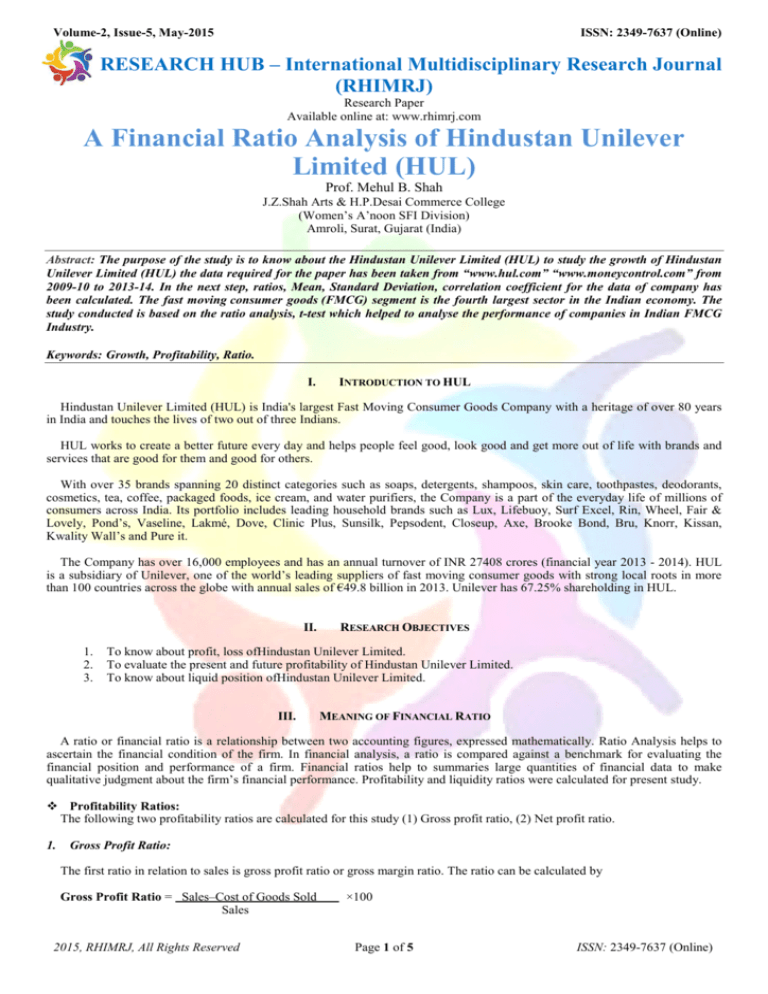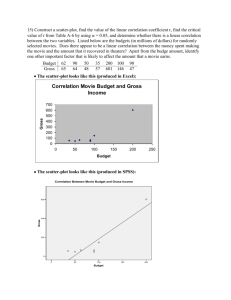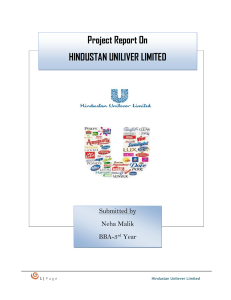
Volume-2, Issue-5, May-2015
ISSN: 2349-7637 (Online)
RESEARCH HUB – International Multidisciplinary Research Journal
(RHIMRJ)
Research Paper
Available online at: www.rhimrj.com
A Financial Ratio Analysis of Hindustan Unilever
Limited (HUL)
Prof. Mehul B. Shah
J.Z.Shah Arts & H.P.Desai Commerce College
(Women’s A’noon SFI Division)
Amroli, Surat, Gujarat (India)
Abstract: The purpose of the study is to know about the Hindustan Unilever Limited (HUL) to study the growth of Hindustan
Unilever Limited (HUL) the data required for the paper has been taken from “www.hul.com” “www.moneycontrol.com” from
2009-10 to 2013-14. In the next step, ratios, Mean, Standard Deviation, correlation coefficient for the data of company has
been calculated. The fast moving consumer goods (FMCG) segment is the fourth largest sector in the Indian economy. The
study conducted is based on the ratio analysis, t-test which helped to analyse the performance of companies in Indian FMCG
Industry.
Keywords: Growth, Profitability, Ratio.
I.
INTRODUCTION TO HUL
Hindustan Unilever Limited (HUL) is India's largest Fast Moving Consumer Goods Company with a heritage of over 80 years
in India and touches the lives of two out of three Indians.
HUL works to create a better future every day and helps people feel good, look good and get more out of life with brands and
services that are good for them and good for others.
With over 35 brands spanning 20 distinct categories such as soaps, detergents, shampoos, skin care, toothpastes, deodorants,
cosmetics, tea, coffee, packaged foods, ice cream, and water purifiers, the Company is a part of the everyday life of millions of
consumers across India. Its portfolio includes leading household brands such as Lux, Lifebuoy, Surf Excel, Rin, Wheel, Fair &
Lovely, Pond’s, Vaseline, Lakmé, Dove, Clinic Plus, Sunsilk, Pepsodent, Closeup, Axe, Brooke Bond, Bru, Knorr, Kissan,
Kwality Wall’s and Pure it.
The Company has over 16,000 employees and has an annual turnover of INR 27408 crores (financial year 2013 - 2014). HUL
is a subsidiary of Unilever, one of the world’s leading suppliers of fast moving consumer goods with strong local roots in more
than 100 countries across the globe with annual sales of €49.8 billion in 2013. Unilever has 67.25% shareholding in HUL.
II.
1.
2.
3.
RESEARCH OBJECTIVES
To know about profit, loss ofHindustan Unilever Limited.
To evaluate the present and future profitability of Hindustan Unilever Limited.
To know about liquid position ofHindustan Unilever Limited.
III.
MEANING OF FINANCIAL RATIO
A ratio or financial ratio is a relationship between two accounting figures, expressed mathematically. Ratio Analysis helps to
ascertain the financial condition of the firm. In financial analysis, a ratio is compared against a benchmark for evaluating the
financial position and performance of a firm. Financial ratios help to summaries large quantities of financial data to make
qualitative judgment about the firm’s financial performance. Profitability and liquidity ratios were calculated for present study.
Profitability Ratios:
The following two profitability ratios are calculated for this study (1) Gross profit ratio, (2) Net profit ratio.
1.
Gross Profit Ratio:
The first ratio in relation to sales is gross profit ratio or gross margin ratio. The ratio can be calculated by
Gross Profit Ratio = Sales–Cost of Goods Sold
Sales
2015, RHIMRJ, All Rights Reserved
×100
Page 1 of 5
ISSN: 2349-7637 (Online)
RESEARCH HUB – International Multidisciplinary Research Journal
Volume-2, Issue-5, May-2015
=
2.
Gross Profit
Sales
x 100
Net Profit Ratio:
Net profit is obtained, after deducting operating expenses, interest and taxes from gross profit. The net profit ratio is calculated
by
Net Profit Ratio =
Profit after Tax
Sales
x100
Net profit includes non-operating income so the later may be deducted to arrive at profitabilityarising from operations.
Liquidity Ratio:
The following two liquidity ratios are calculated for this study
1.
2.
1.
Current ratio
Liquidity ratio
Current Ratio:
Current ratio is defined as the relationship between current assets and current liabilities. It is also known as working capital
ratio. This is calculated by dividing total current assets by total current liabilities.
Current Ratio =
2.
Current Assets
Current Liabilities
Liquid ratio:
Liquid ratio establishes the relationship between liquid assets and current liabilities. Liquid assets are those that can be
converted into cash, quickly, without loss of value. Cash and balance in current account with bank are the most liquid assets.
Liquid Ratio =
Liquid Assets
Liquid Liabilities
IV.
SCOPE OF THE STUDY
The study covers analysis of financial statements of Hindustan Unilever Limited (HUL) for the period 2009-2010 to 2013-2014.
It can be extended to future period also. With the help of statistical analysis, the forecasting of subsequent years can also be made
for particular item such as sales, inventory, profit, etc. The statistical analysis can also be applied to every ratio and by their upon
more comprehensive results can be obtained. The statistical analysis can also be applied to other similar companies as well as the
industry as a whole in order to know the prevailing situation in the whole industry.
V.
1.
2.
3.
4.
LIMITATIONS OF DATA
The study is based on historical data.
The study depends on the secondary data obtained from www.money control.com, www.gnfc.in.
Accounting techniques used for the study like ratio analyses have its own limitations.It is calculated from past data. So
it is no useful to assume the future.
Financial statements are primarily based on cost concept. Hence, it cannot give the current position.
VI.
DATA ANALYSIS
Gross Profit Ratio:
Year
2009-10
2010-11
2011-12
2012-13
2013-14
2015, RHIMRJ, All Rights Reserved
Gross Profit
2612.06
2457.07
3071.96
3765.71
4214.08
Net Sales
17769.12
19735.51
22116.37
25810.21
28019.13
Page 2 of 5
Ratio
14.70
12.45
13.89
14.59
15.04
ISSN: 2349-7637 (Online)
RESEARCH HUB – International Multidisciplinary Research Journal
Volume-2, Issue-5, May-2015
Statistical Techniques:
Particulars
Gross Profit
Net Sales
Mean
3,224.18
22,690.07
Standard Deviation
751.57
4225.18
The correlation coefficient between Gross Profit and Net Sales is 0.97
Testing of Hypothesis:
H0: There is no linear correlation between Gross Profit and Net sales.
H1: There is linear correlation between Gross Profit and Net sales.
tcal
t 0.05
= 7.01
= 3.18
tcal > t0.05
The hypothesis is rejected so we can say that there is linear correlation between Gross Profit and Net sales.
Net Profit Ratio:
Year
2009-10
2010-11
2011-12
2012-13
2013-14
Net Profit
2202.03
2305.99
2691.4
3796.67
3867.49
Net Sales
17769.12
19735.51
22116.37
25810.21
28019.13
Ratio
12.39
11.68
12.17
14.71
13.80
Statistical Techniques:
Particulars
Net Profit
Net Sales
Mean
2,972.72
22,893.29
Standard Deviation
805.782
4556.97
The correlation coefficient between Net Profit and Net Sales is 0.96
Testing of Hypothesis:
2015, RHIMRJ, All Rights Reserved
Page 3 of 5
ISSN: 2349-7637 (Online)
RESEARCH HUB – International Multidisciplinary Research Journal
Volume-2, Issue-5, May-2015
H0: There is no linear correlation between Net Profit and Net sales.
H1: There is linear correlation between Net Profit and Net sales.
tcal
t 0.05
= 6.36
= 3.18
tcal > t0.05
The hypothesis is rejected so we can say that there is linear correlation between Net Profit and Net sales.
Current ratio:
Year
2009-10
2010-11
2011-12
2012-13
2013-14
Current Assets
5818.89
6444.13
6157.14
6673.27
7162.44
Current liability
6935.52
7503.14
7445.34
8838.45
9721.35
Ratio
0.84
0.86
0.83
0.76
0.74
Statistical Techniques:
Particulars
Current Assets
Current Liabilities
Mean
6,451.17
8,088.76
Standard Deviation
510.27
1152.64
The correlation coefficient between current assets and current liability is 0.96
Testing of Hypothesis:
H0: There is no linear correlation between Current Assets and Current liability.
H1: There is linear correlation between Current Assets and Current liability
tcal
t 0.05
= 5.66
= 3.18
tcal > t0.05
The hypothesis is rejected so we can say that there is linear correlation between Current assets and Current liability.
Liquid Ratio:
Year
2009-10
2010-11
2011-12
2012-13
2013-14
2015, RHIMRJ, All Rights Reserved
Liquid Assets
3638.96
3633.36
3640.49
4146.28
4414.91
Liquid liability
6935.52
7503.14
7445.34
8838.45
9721.35
Page 4 of 5
Ratio
0.52
0.48
0.49
0.47
0.45
ISSN: 2349-7637 (Online)
RESEARCH HUB – International Multidisciplinary Research Journal
Volume-2, Issue-5, May-2015
Statistical Techniques:
Particulars
Liquid Assets
Liquid Liabilities
Mean
3,894.80
8,088.76
Standard Deviation
364.77
1152.64
The correlation coefficient between liquid assets and liquid liability is 0.98
Testing of Hypothesis:
H0: There is no linear correlation between Liquid Assets and Liquid liability.
H1: There is linear correlation between Liquid Assets and Liquid liability.
tcal
= 8.70
t 0.05
= 3.18
tcal > t0.05
The hypothesis is rejected so we can say that there is linear correlation between Liquid assets and Liquid liability.
VII.
CONCLUSION
The sales of company are increasing during last five years but the gross profit was not increasing in proportionate term. The
sales are increasing speedily but the growth of gross profit was in slow manner. There was no large difference between gross
profit ratio and net profit ratio. So we can say that company spent lower amount on operating expense. Standard Current ratio is
2:1 while for last five years company was having lower than 1 ratio which proves threat for company. As the same the standard
liquid ratio is 1:1 while the ratio was averagely near to 0.5 for last five year. We can say that the company was having low
liquidity.
REFERENCES
1.
2.
3.
4.
5.
Cooper, D. R., Chindler, P. S., & Sharma, J. K. (2012). Business Reseach Methods. New Delhi: Mcgraw Hill Education Pvt. Ltd
Kothari, C. R. (2004). Research Methodology Methods and Techniquies. New Delhi: New Age International Pvt.Ltd.
EXCEL International Journal of Multidisciplinary Management Studies Vol.2 Issue 3, March 2012
www.moneycontrol.com
www.hul.com
2015, RHIMRJ, All Rights Reserved
Page 5 of 5
ISSN: 2349-7637 (Online)








